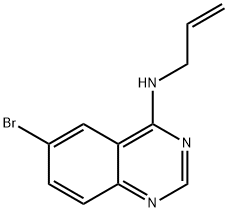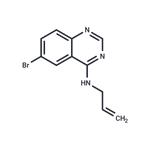SMER28 (CAS 307538-42-7) Induces autophagy via an mTOR-independent pathway. Enhances clearance of ?-amyloid protein in cell lines and primary neuronal culture models.1-3? May be a useful lead compound for the development of new therapeutics for neurodegenerative diseases.4?Induces the release of articular cartilage vesicles from healthy articular chondrocytes in a dose- and time-dependent manner.5? Promotes reprogramming of fibroblasts to neural stem-like cells.6?Cell permeable.
SMER 28 is a positive regulator of autophagy in a mechanism independent from the mTOR pathway. SMER 28 increases autophagosome synthesis and enhances clearance of model autophagy substrates such as A53T α-synuclein associated with Huntington''s disease.
SMER28 may be used in mTOR-mediated signaling studies.
ChEBI: SMER 28 is a member of the class of quinazolines that is quinazoline which is substituted by a prop-2-en-1-ylnitrilo group and a bromo group at positions 4 and 6, respectively. It is a modulator of mammalian autophagy. It has a role as an autophagy inducer. It is a member of quinazolines, a secondary amino compound and an organobromine compound.
SMER28 is a small molecule modulator of mammalian autophagy; enhances A53T alpha-synuclein clearance in PC-12 cells independent of rapamycin treatment; appears to act independent of the mTOR pathway, but combined treatment with saturating rapamycin concentration enhances the effect of either compound alone on A53T alpha-synuclein clearance; autophagy inducers may prove useful in the treatment of neurodegenerative and infectious diseases and cancer.
smer 28 independently induced autophagy of rapamycin in mammalian cells, enhancing the clearance of autophagy substrates such as a53t a-synuclein and mutant huntingtin, which were associated with huntington’s and parkinson’s disease. smer 28, which seemed to act either independently or downstream of the rapamycin target, was found to attenuate the mutant huntingtin-fragment toxicity in huntington’s disease cells [1].
previous study confirmed that the reduction of egfp-hdq74 aggregation occured through autophagy using autophagy-competent mouse embryonic fibroblasts (mefs) (atg5+/+). egfp-hdq74 aggregation was increased significantly in untreated atg5-/- (autophagy-deficient) cells when compared with untreated atg5+/+ cells. smer 28 reduced egfp-hdq74 aggregation in atg5+/+ cells significantly, but not in atg5-/- cells). therefore, smer 28 could only reduce mutant huntingtin aggregation in autophagy-competent cells [1].
1) Tian et al. (2011), A small-molecule enhancer of autophagy decreases levels of Abeta and APP-CTF via Atg5-dependent autophagy pathway; FASEB J., 25 1934
2) Tian et al. (2014), The convergence of endosomal and autophagosomal pathways; implications for APP-CTF degradation; Autophagy, 10 694
3) Shen et al. (2011), Novel cell- and tissue-based assays for detecting misfolded and aggregated protein accumulation within aggresomes and inclusion bodies; Cell Biochem. Biophys., 60 173
4) Renna et al. (2010), Chemical inducers of autophagy that enhance the clearance of mutant proteins in neurodegenerative diseases; J. Biol. Chem., 285 11061
5) Rosenthal et al. (2015), Autophagy modulates articular cartilage vesicle formation in primary articular chondrocytes; J. Biol. Chem., 290 13028
6) Zhang et al. (2016), Pharmacological Reprogramming of Fibroblasts into Neural Stem Cells by Signaling-Directed Transcriptional Activation; Cell Stem Cell., 18 653


